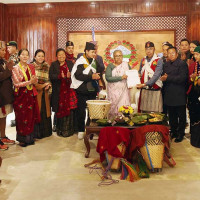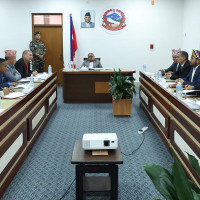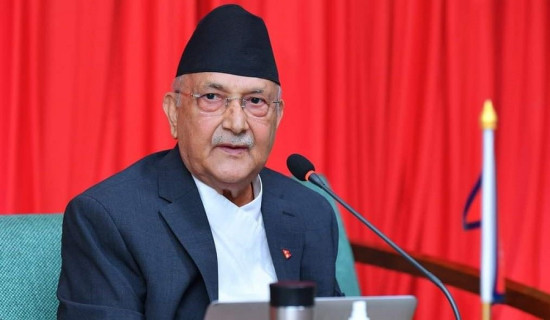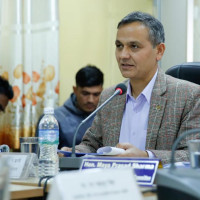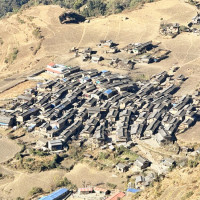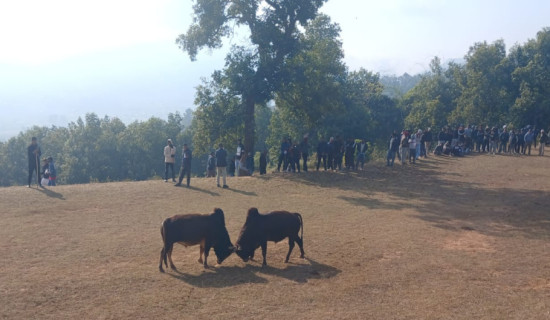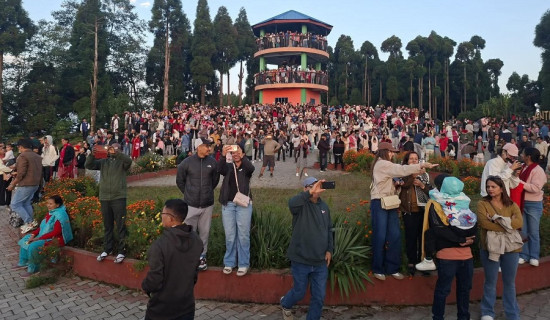- Friday, 2 January 2026
Rato Machhindranath Festival in Dolakha
The Rato Machhindranath festival began on the 29th of Baisakh in Lalitpur by pulling its chariot. The chariot, after revolving around all the toles of Patan, is brought to Jawalakhel on the day of Asar Sukla Chauthi, where the famous Bhoto is displayed and the festival ends. However, this festival is not limited to Lalitpur alone, even if the Bhoto is not displaced as in Lalitpur.
The Rato Machhindranath Jatra (festival) is celebrated only in the historical town of Dolakha outside the Kathmandu valley. As a festival of chariots, Bhaktapur has a Bisket Jatra, Kathmandu has a Seto Machhindranath Jatra, Patan has a Rato Machhindranath Jatra, and Dolakha also has a Rato Machhindranath Jatra. Machhindranatha is also known as the Karunamaya Bodhisattwa Abloketeswar. The festival of Machhindranath, celebrated in the month of Baisakh, seeks blessings from the deity, known as the god of rain and prosperity, to bring forth rainfall crucial for agricultural prosperity. It is said that the onset of rainfall follows the culmination of this vibrant celebration.
Beginning of festival
The Machhindranath festival, celebrated for nine days, is one of the main festivals of Dolakha town, which is inhabited exclusively by the Newar community. Looking at the physical structure of Dolakha town, the narrow stone-paved roads beside having stairs in some parts of the road, and above all the steep uphill of the road, no one would easily believe that the large chariot of Machhindranath revolved around the city. Once, one of my friends, after watching on television the pulling of a chariot through the steep, winding, and narrow roads of Dolakha town, was extremely amazed and, out of curiosity, asked me how it was done.
According to a legend, Machhindranath installed Bungmati in Patan in 632 B.S. to make rainfall to get relief from a long-time drought. However, available evidence indicates that in Dolakha, the festival was started only in 1575 B.S. during the reign of Nandadev Singh, the king of Dolakha, about 505 years ago. It follows that by the order of King Shri Gurudev Bajracharya, a small, eight-inch-sized replica of Rato Machhindranath was brought from Bungmati on the 17th Baisakh of 1575 B.S. and installed in a temple built in Dwakulunga tole. Since at that time, Dolakha town was a trading hub, traders and businessmen from Patan and Bhaktapur used to live in Dolakha for business purposes. It is obvious that since Machhindranath was brought from Bungmati, the deity is called ‘Bungdeo‘ in Kathmandu Valley and ‘Bugdeu’ in Dolakha, where ‘Deu’ means god in the local language.
To make the Jatra sustainable, King Basudeva of Dolakha gave land to the Thami community of Lapilang in 1650 B.S. under a Guthi to construct and maintain the Machhindranath's chariot every year. As per that, the Thamis from Lapilang village, east of Dolakha city, used to come to Dolakha bringing wood, bamboo, ropes, wild garlands, etc. required to construct the chariot every year. They used to return to their homes only after fully constructing the chariot. At that time, it was believed that a chariot with four wheels should be 32 haat (feet) in height. The tradition of pulling chariots in this jatra has had to stop since 2039 B.S. due to financial difficulties. Later, with the initiative of the Kalinchok Youth Club and people’s participation, the Jatra was resumed in 2055 B.S., which is now celebrated with more fanfare than before.
Celebrated for nine days
This festival is celebrated for nine days, from Baisakh Purnima to Astami. On the first day of the festival or Purnima, the idol of Machchindranath is bathed in milk and worshipped. On that day, interested women fasted and lit lamps at night. On the second day, Guthiyar (trustees) and Gubaju, by playing traditional music, come from Pingal tole to the temple in Dwakulunga tole. Then they carry the idol of Machhindranath to Pingal Tole and install it on the chariot kept there. To keep the chariot balanced, a large and long piece of wood is placed in the middle of the chariot, which is called "Darmashi'' in the local language. The mask of Bhairav is fixed in Darmashi, and a sheep is sacrificed on the mask as a sign of reverence.
Since the priest of Machchindranath is a Gubaju, the festival looks like a festival of Buddhists, but the people of Dolakha, despite most of them being Hindus, celebrate this festival with great enthusiasm. On the third day, from Dwitiya around 3 p.m., the chariots start pulling from Pingal tole. Traditional music is played frequently throughout the pulling time. Sitting on the chariot, a person says "Hoste '' loudly, and others respond by saying "Haise '' and pulling the chariot. In this way, on the first day of pulling, the chariot is stopped for a night in the Nakchhe tole, the second day in the Korchhe tole, the third day in the Tasicha tole, the fourth day in the Mathillo tole, the fifth day in the Dungal tole, and finally, on the sixth day, the chariot is returned to the Pingal tole, the point of origin.
The most difficult day of the journey of the chariot around Dolakha town is the day of pulling the chariot from Tasicha tole to Mathillo tole. Since on that day the chariot will have to be pulled up on the steep uphill of the road known as Rasni, a special arrangement must be made for that purpose. This job needs strong and experienced men to pull the chariot upwards without any accidents or losses. Since the Jatra is worth observing on that day, crowds of people from far and wide assemble in Dolakha town and take part in chariot pulling. Due to the availability of transport facilities, people from Kathmandu Valley overwhelmingly participate in the festival on that day, and it becomes difficult even to get parking areas. The devotees from Kathmandu Valley become active as if the festival were their own. Apart from worshipping the god and pulling the chariot, they play different music, provide drinking water to the devotees fetching from faraway stone taps called Raiti, and sing Bhajan in the evening.
Machindranath temple
The roaming of the chariot around Dolakha town is completed within six days if there are no accidents during the festival, such as the breakdown of the chariot. If the chariot breaks down or falls on the ground, it is considered a bad omen, and the trustees beg for forgiveness by sacrificing a sheep. According to the prevailing custom, the trustee of the tole, where Machchindranath's chariot reaches, performs a puja called "Twal Puja '' on behalf of the people of the tole. The speciality of this festival is that the residents of the tole where Machindranath reaches celebrate the festival and eat a delicious Newari feast on that day. It is customary for the residents of the tole to invite their friends and relatives for the feast or to send the food called "byakoon" in the local language to the relatives. During this festival, children make and sell "Tilauri," called "Chaksala '' in the local language, made by cooking Chaku. During my childhood, I also used to make and sell chaksala to earn a little bit of money.
Final day
On the final day of the festival, the idol of Machhindranath is brought back to its temple in Dwakulunga tole by playing traditional music and singing Bhajans. The residents of Dwakulunga tole seem overly happy on that day, not only because the deity of their tole is returning home but also because it is their day of celebrating the festival and eating a delicious feast. The women of the tole welcome Machhindranath by sitting in queues on two sides of the road, offering garlands, and performing puja on the deity with great reverence. In the courtyard of the temple, first, the priest, called Gubaju, worships Machhindranath according to the ritual. After that, in the course of entering the temple, the Gubaju sitting at the door of the temple recites a sloka loudly to make it audible to all assembled there, saying, "May the effect of this Rath Yatra save all living beings, the whole world, and the then king of Nepal," and takes Machhindranath inside the temple. It may be guessed that since Machhindranath was brought from Bungmati of Newari-speaking Patan by a Gubaju, the sloka is still recited in Nepal Bhasha (Newari language). This year, this festival was celebrated from the 11th of Baisakh to the 19th of Baisakh with great fanfare.
(The author is a professor of business economics.)




